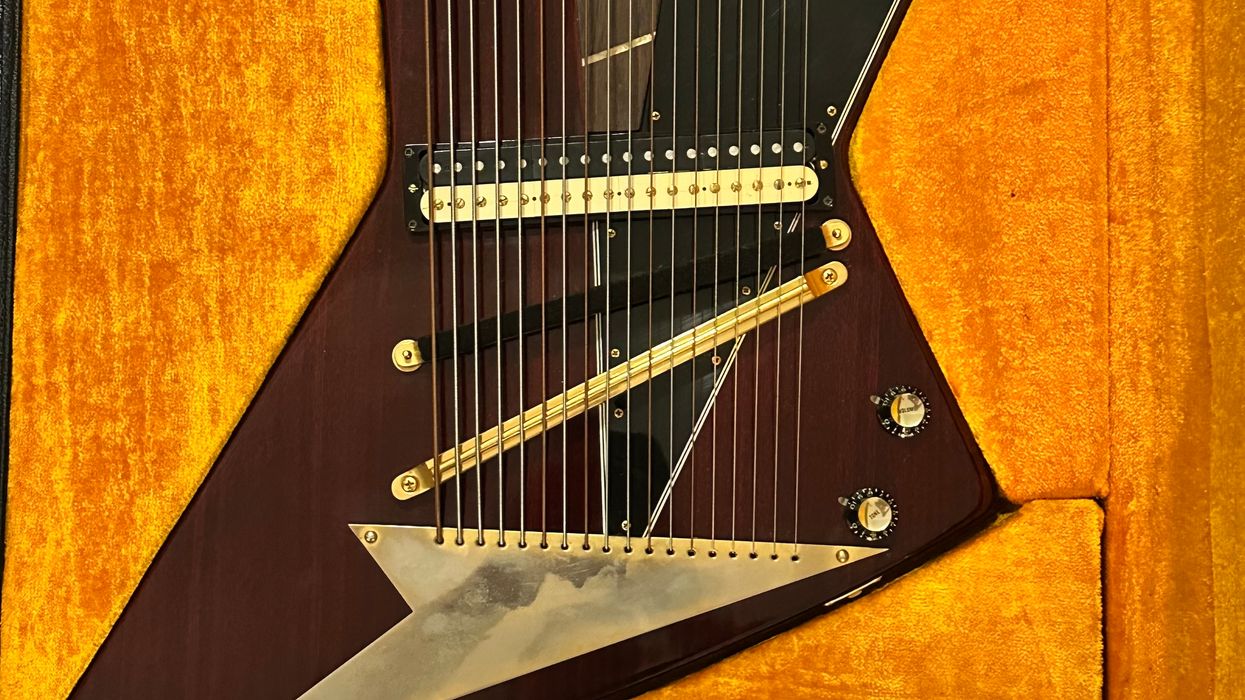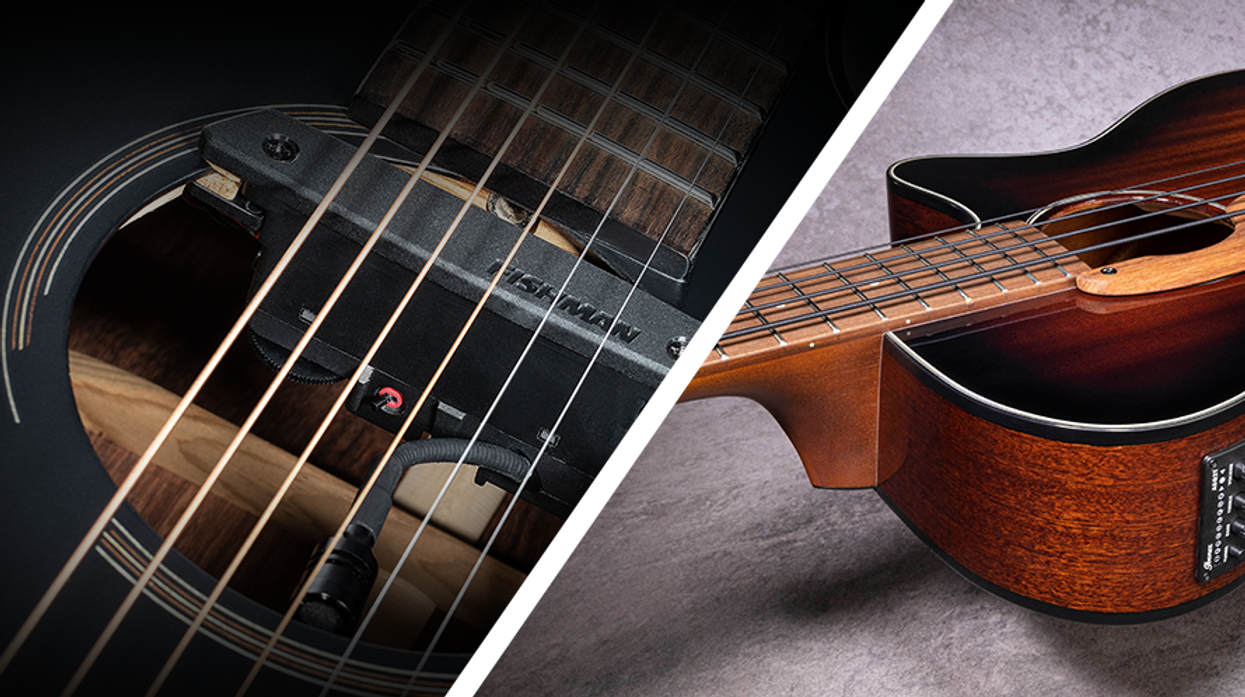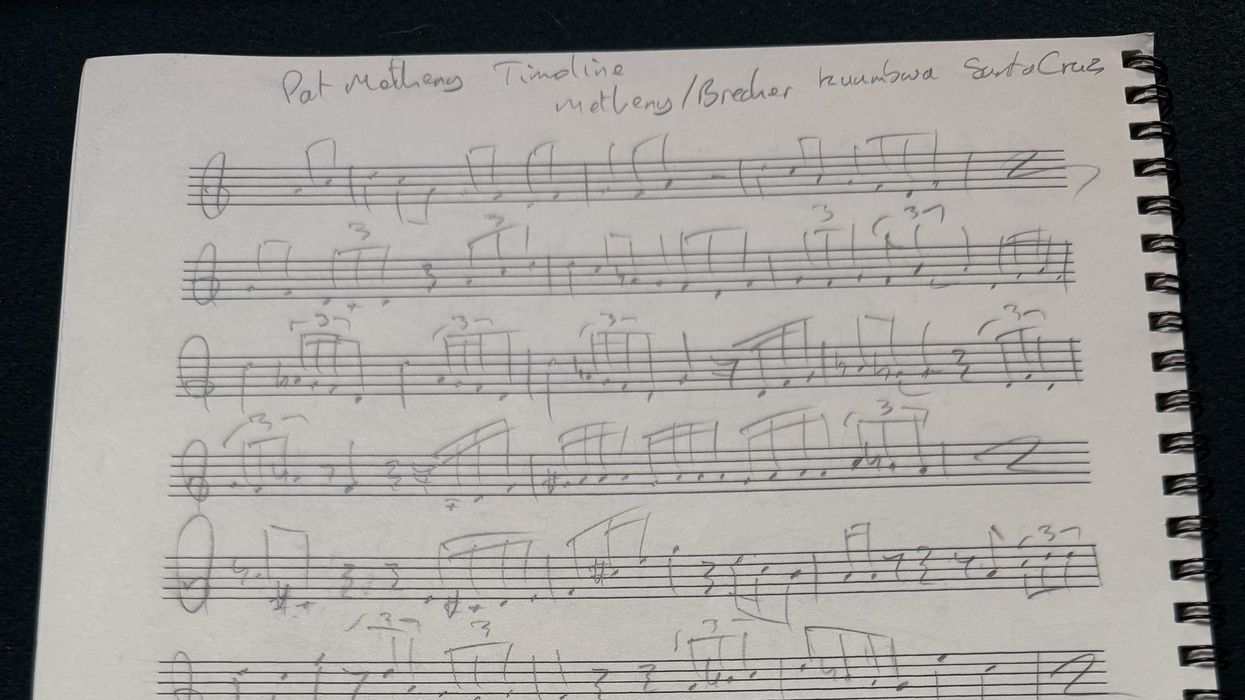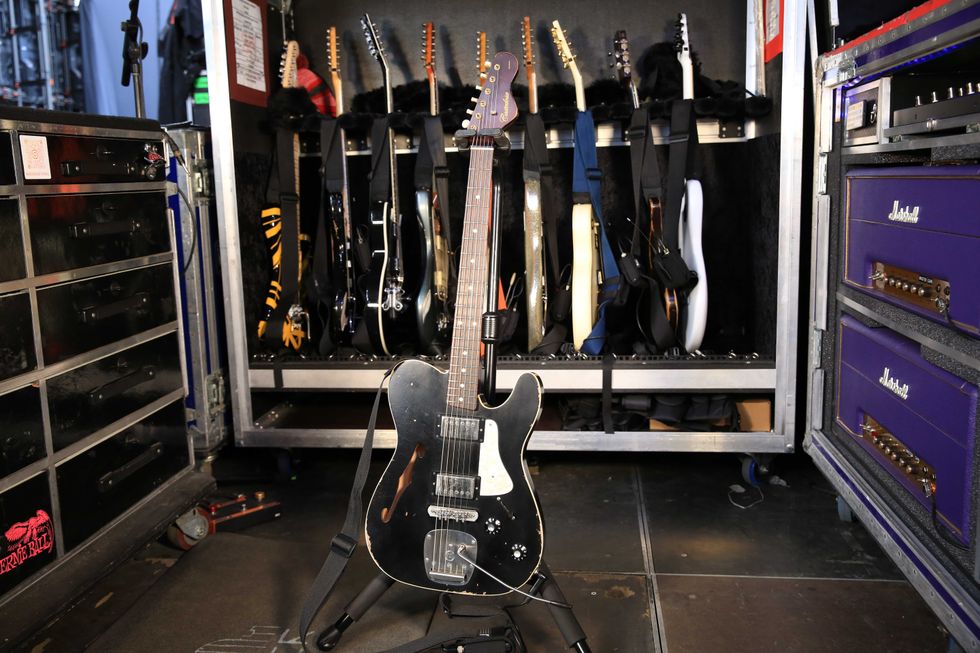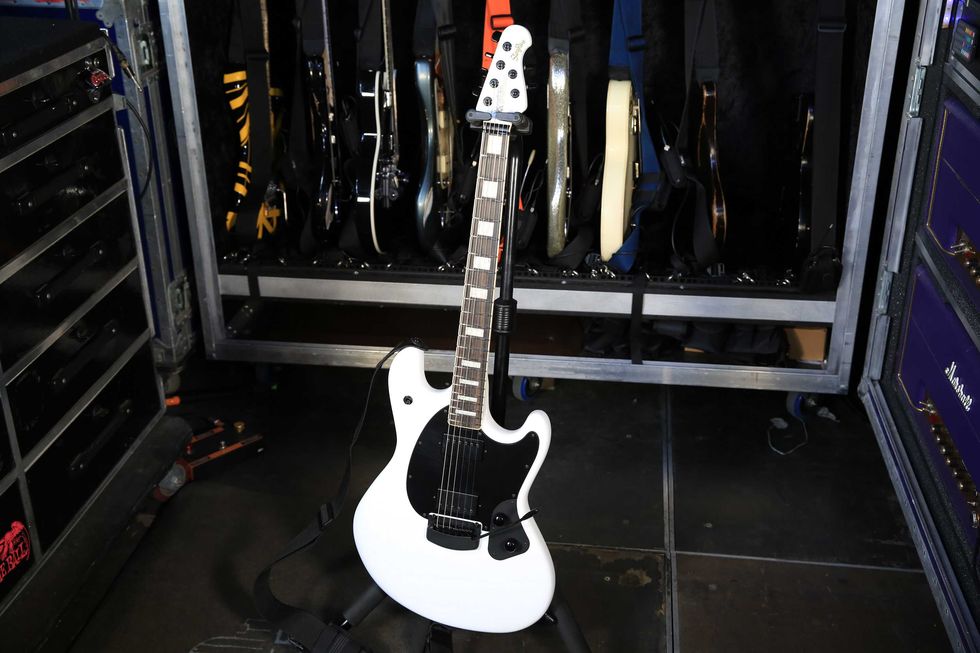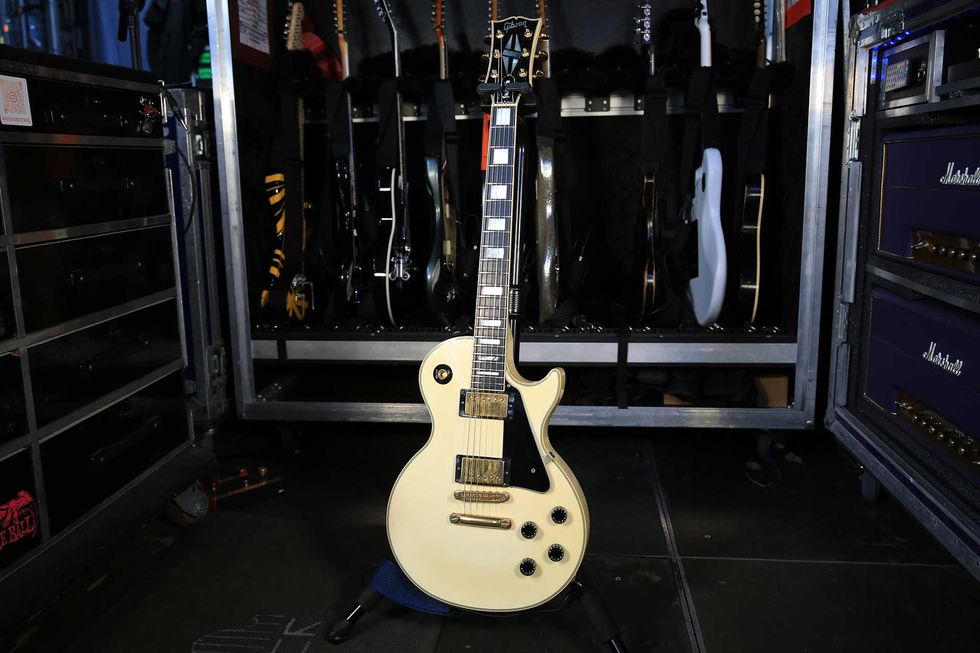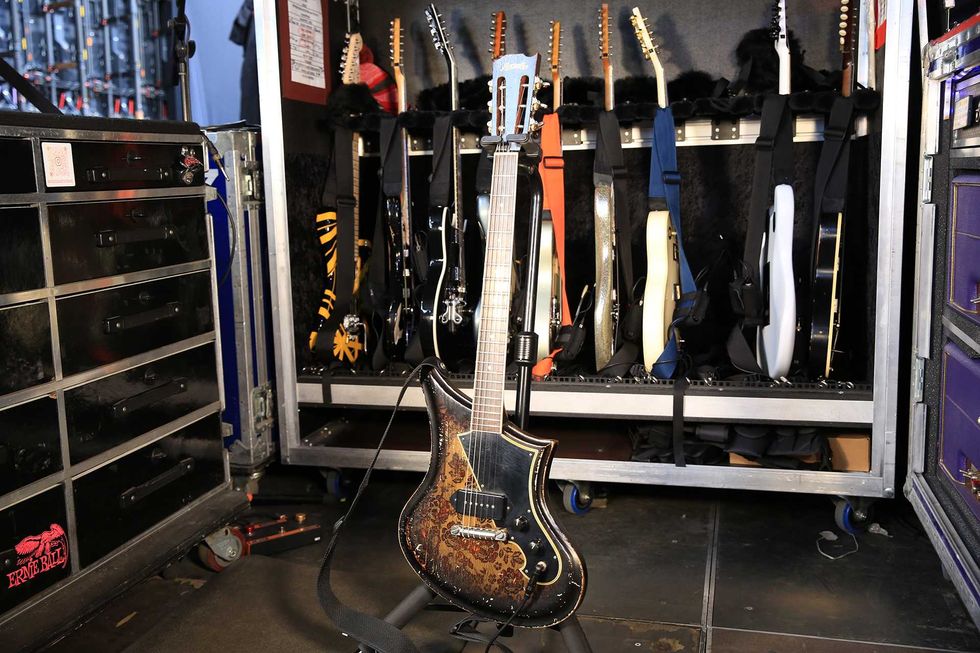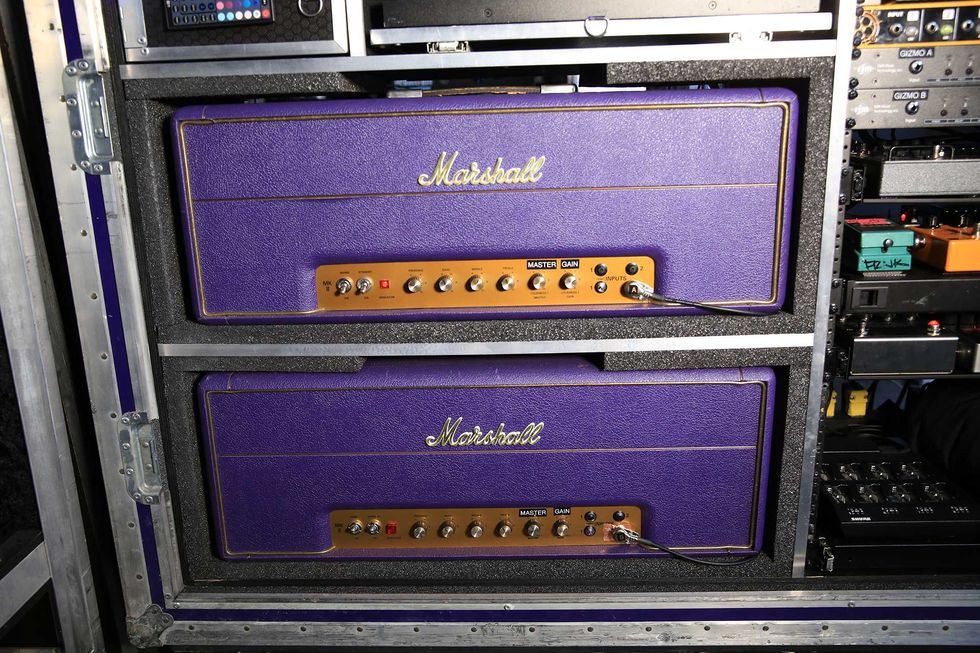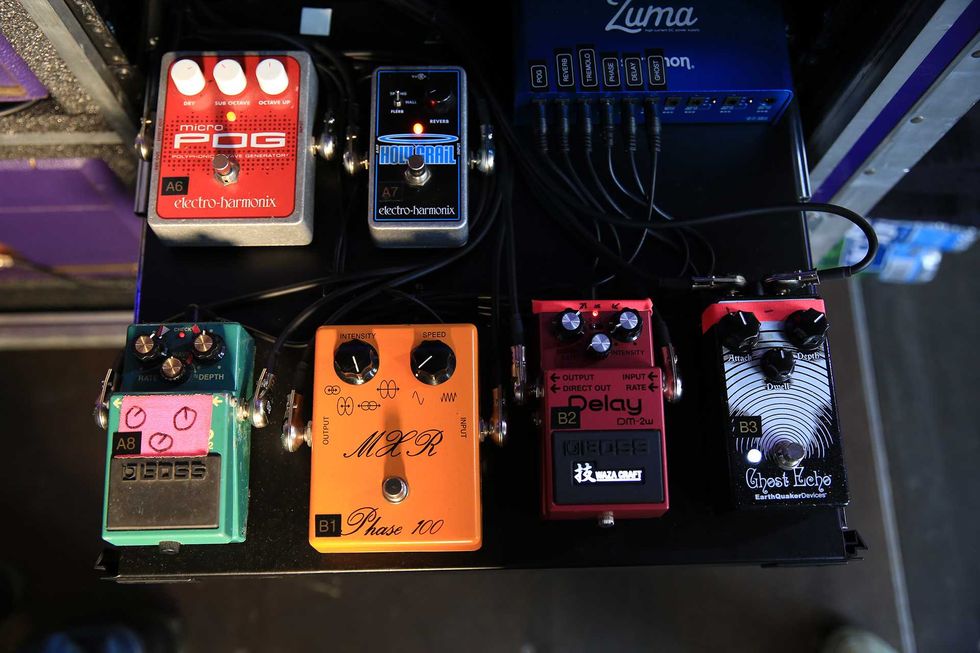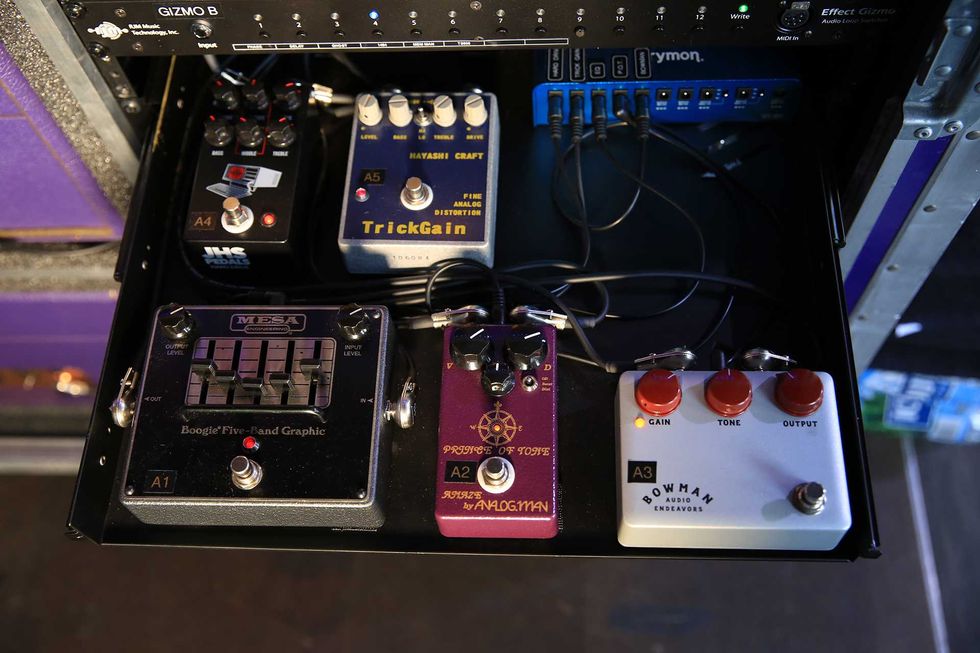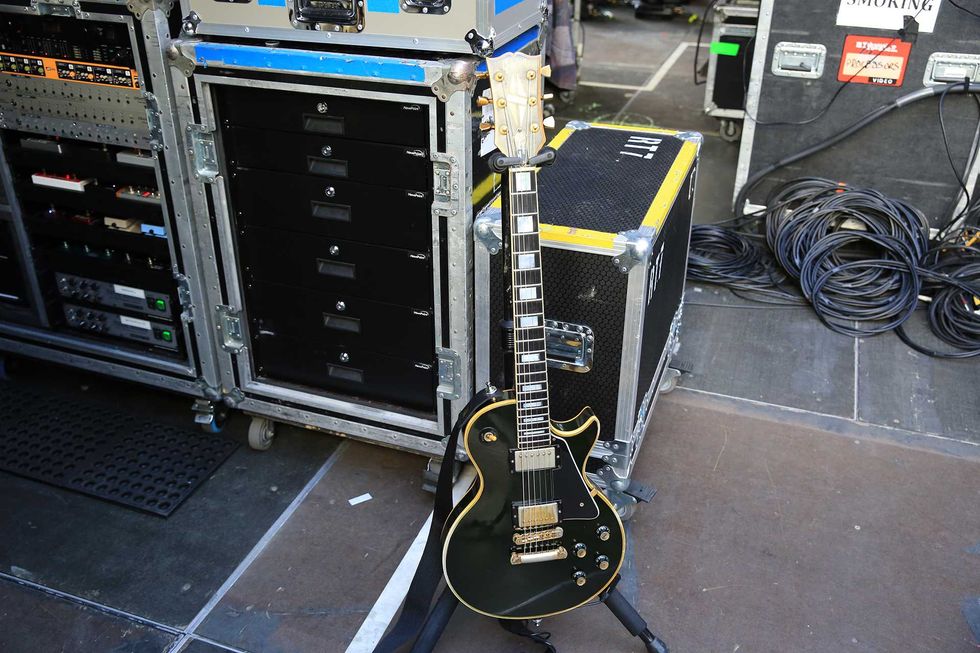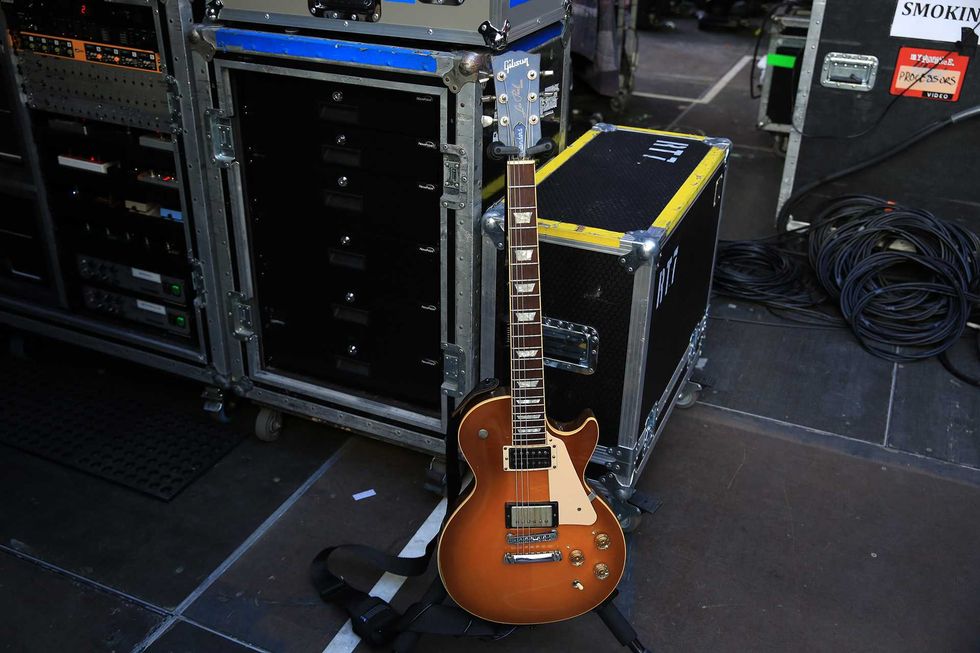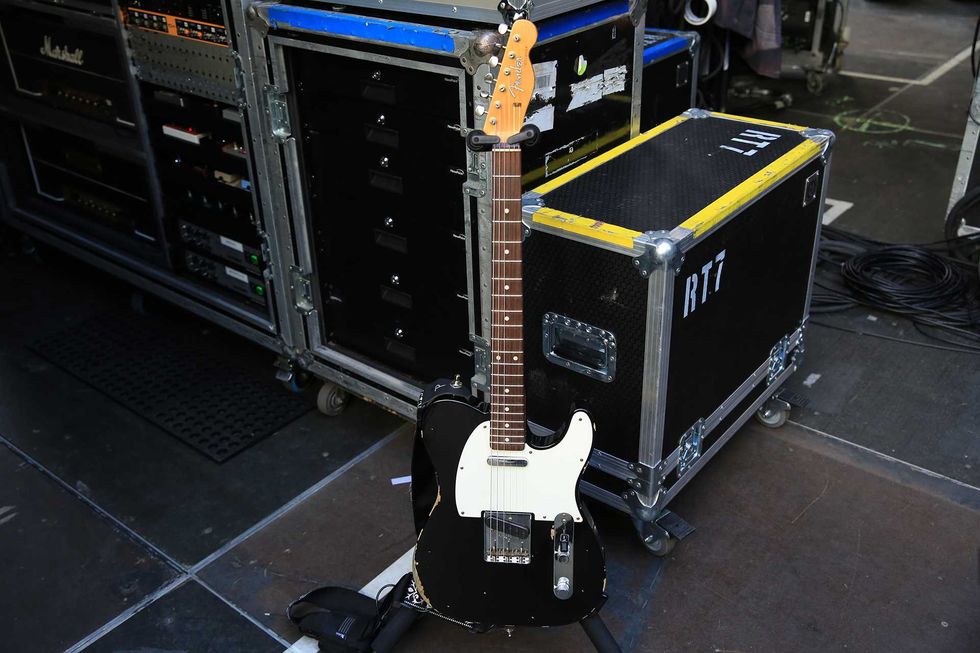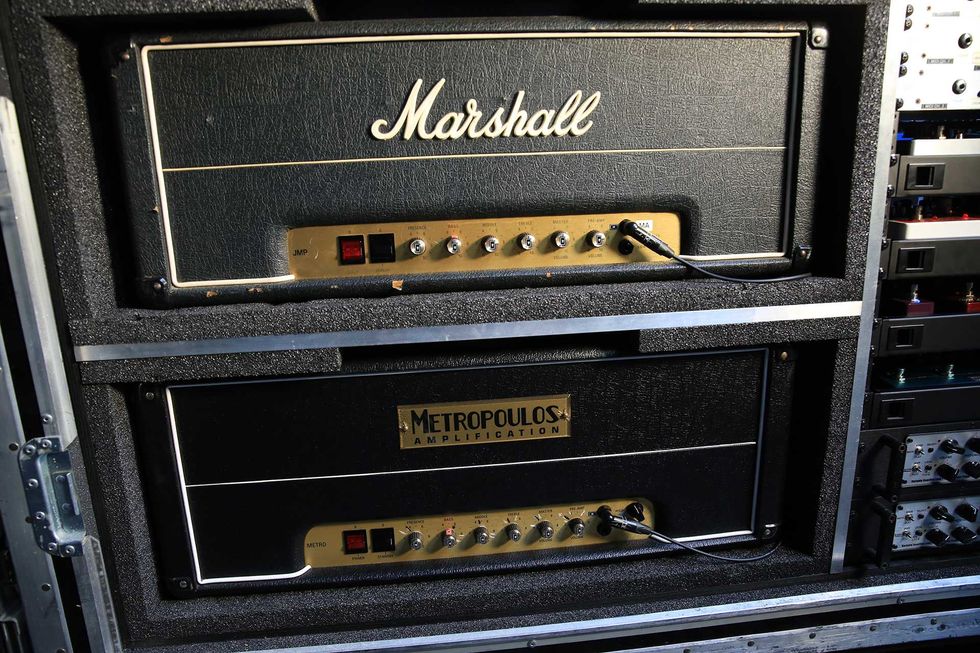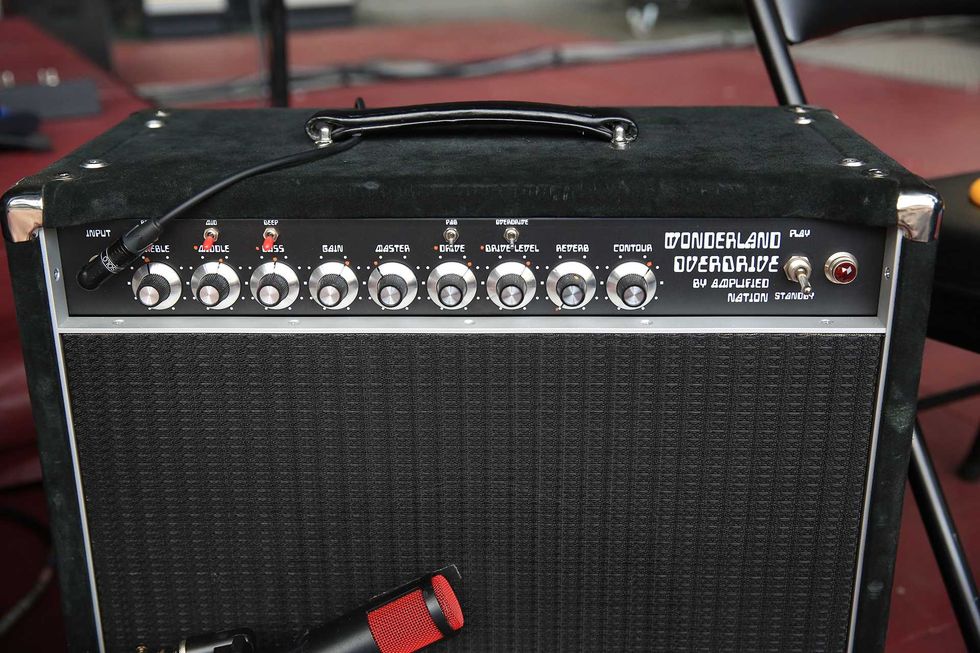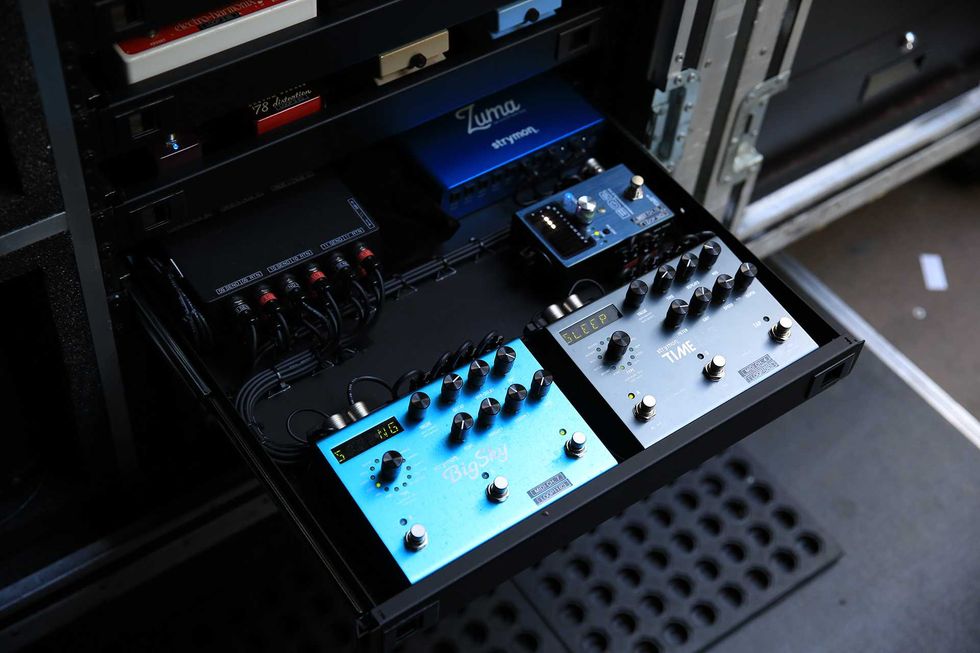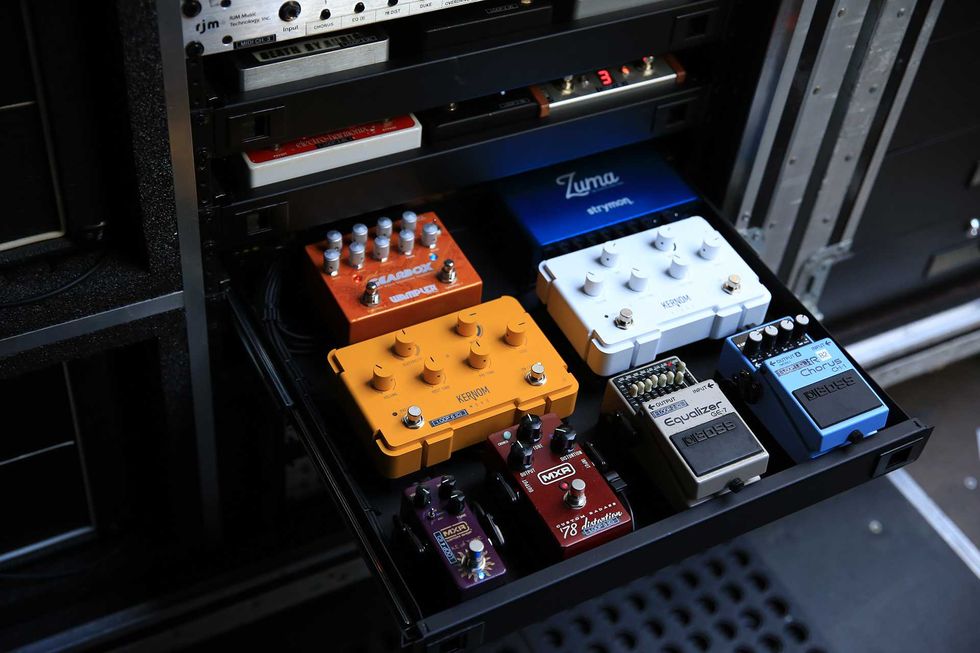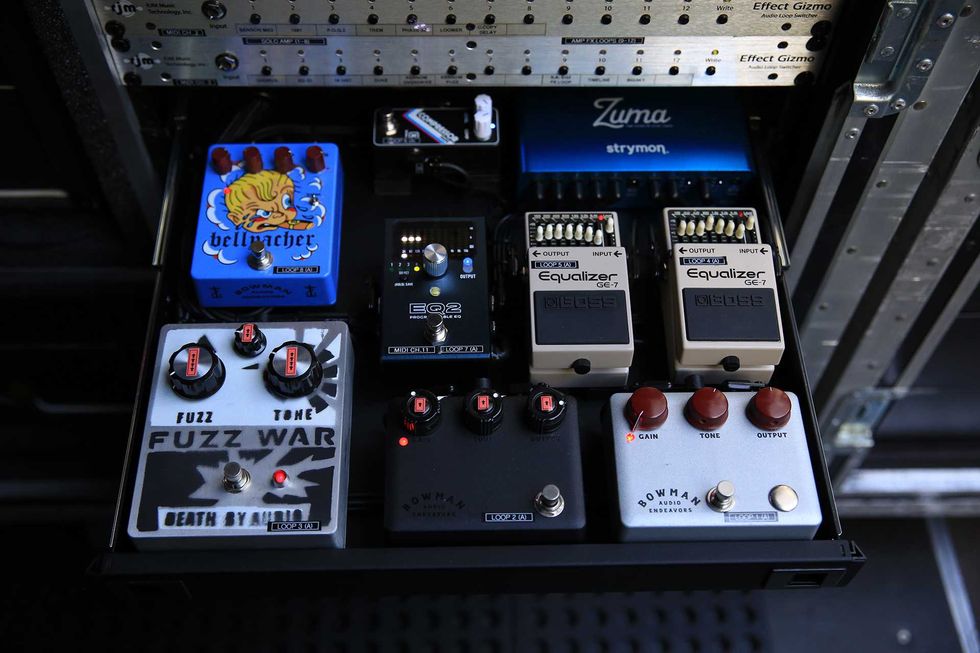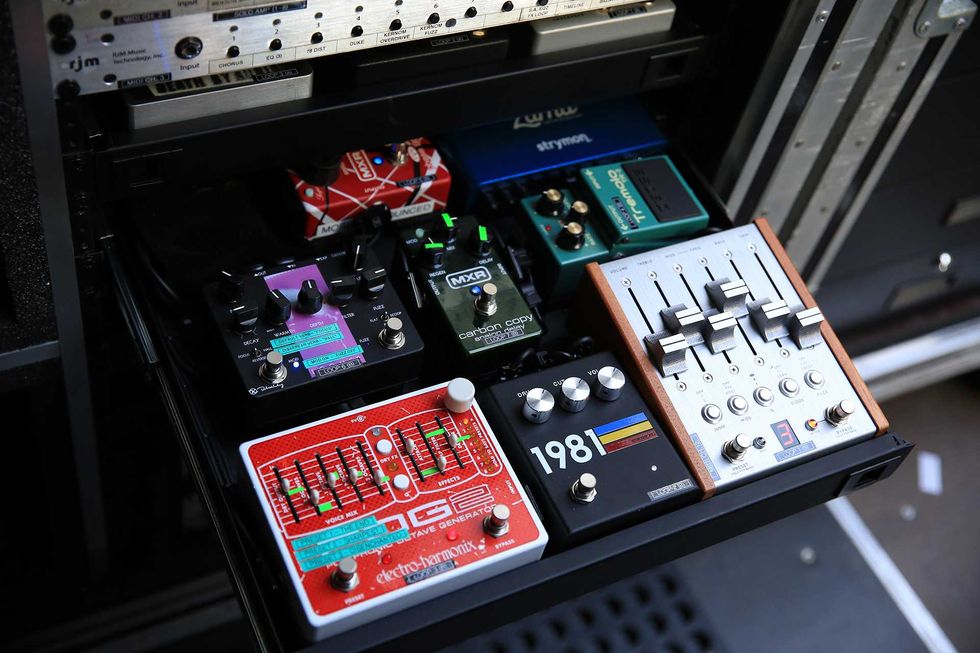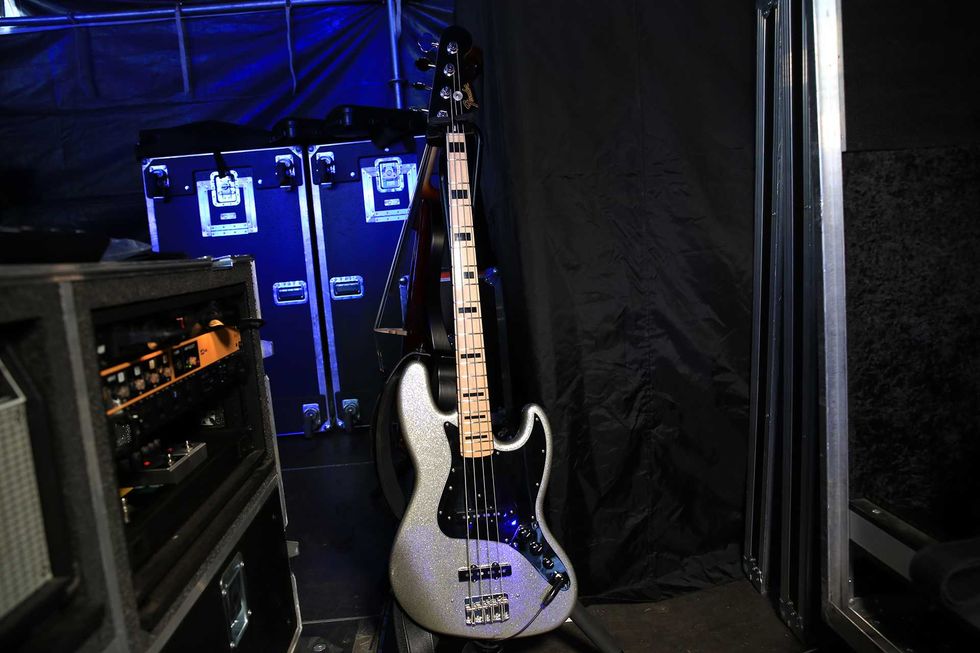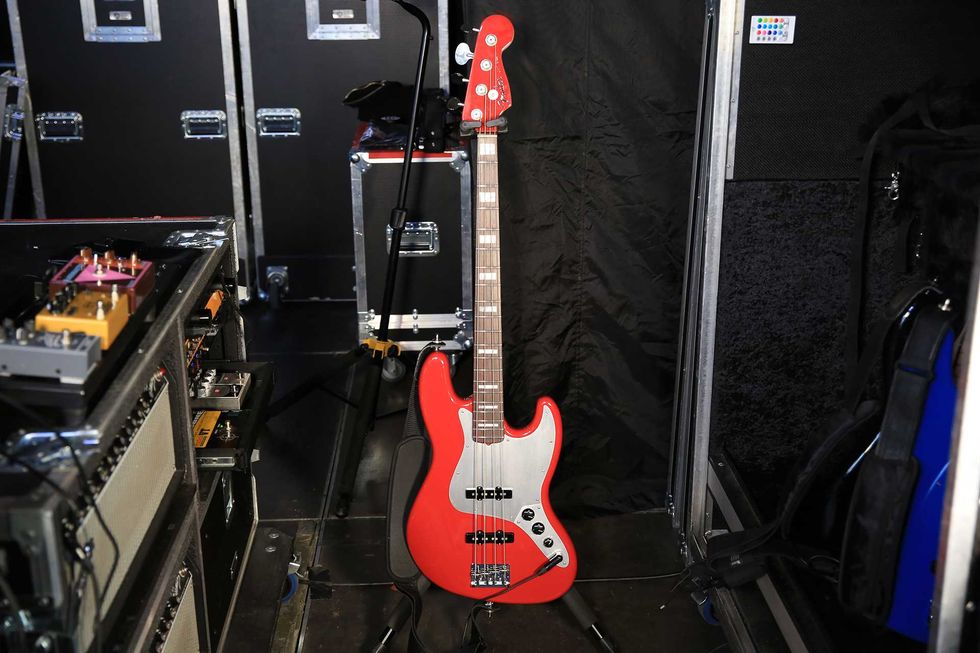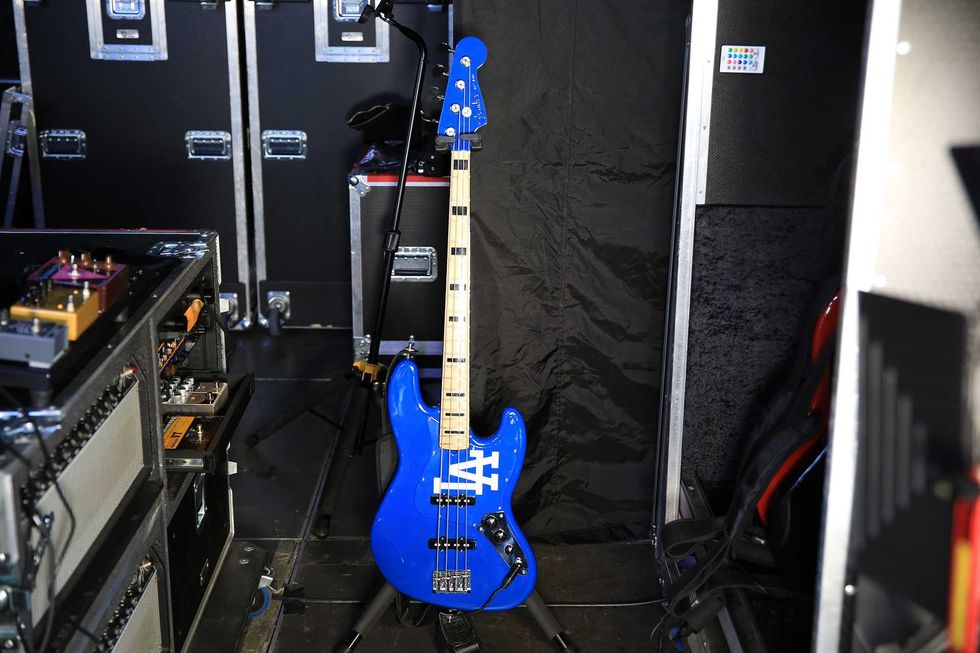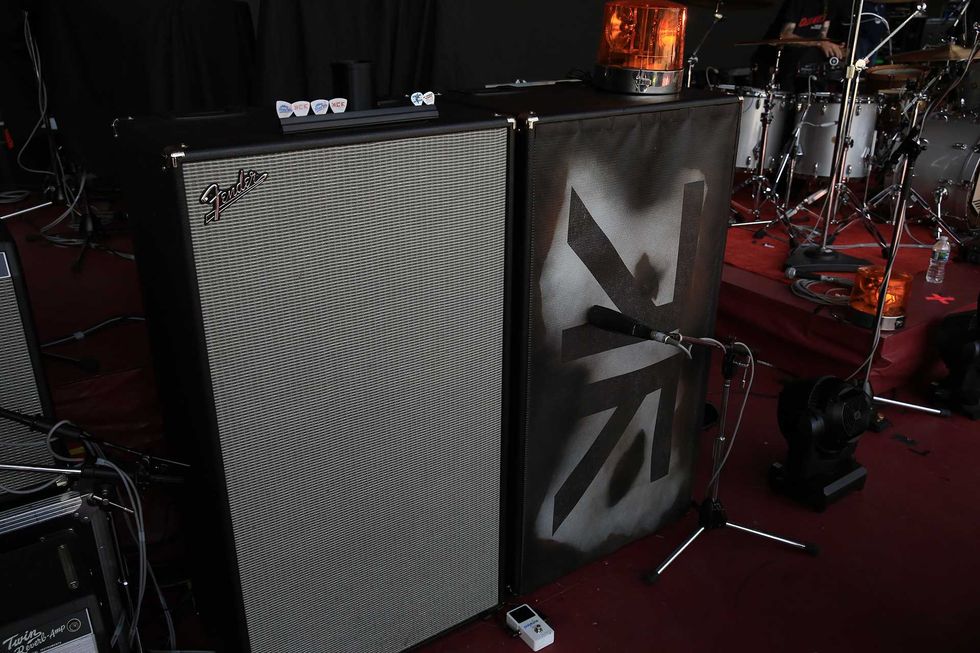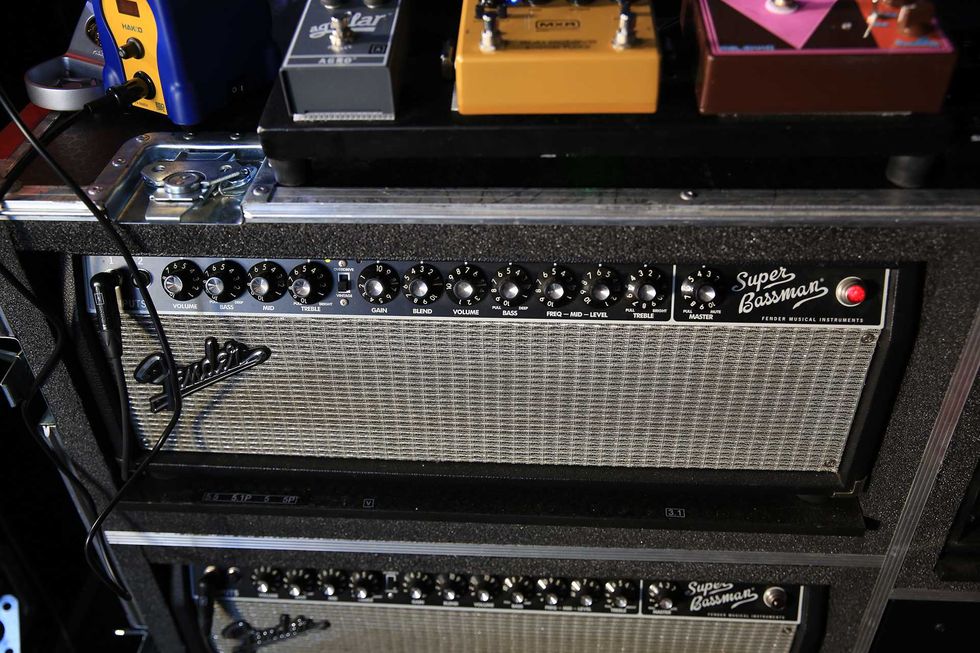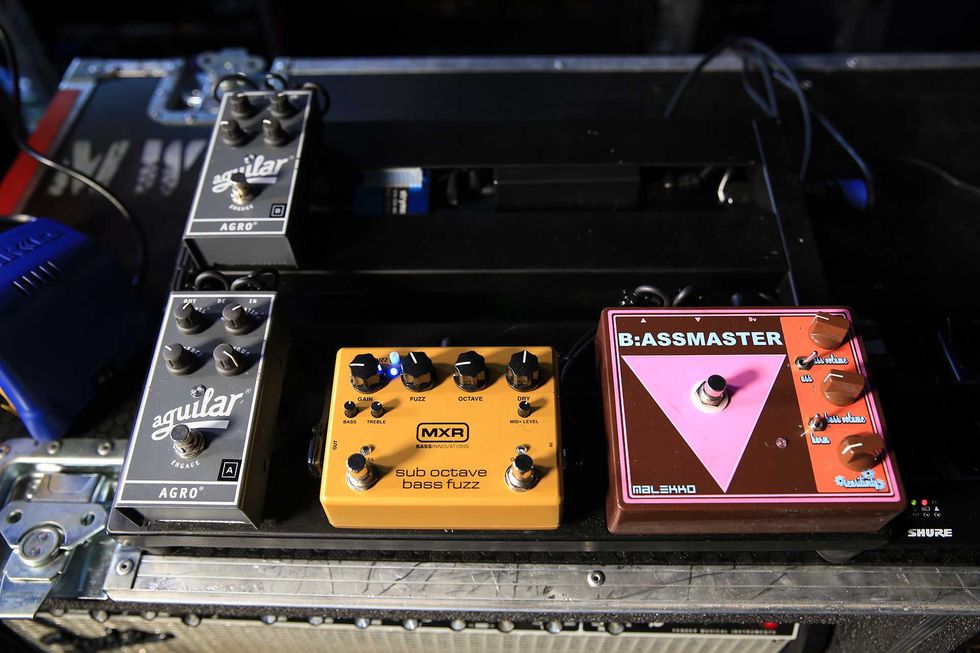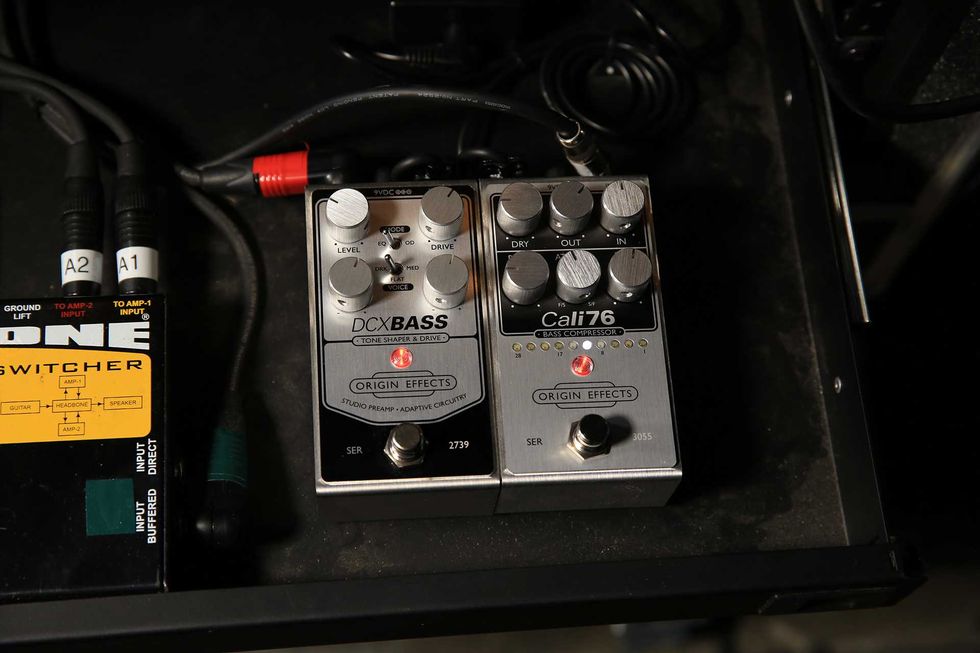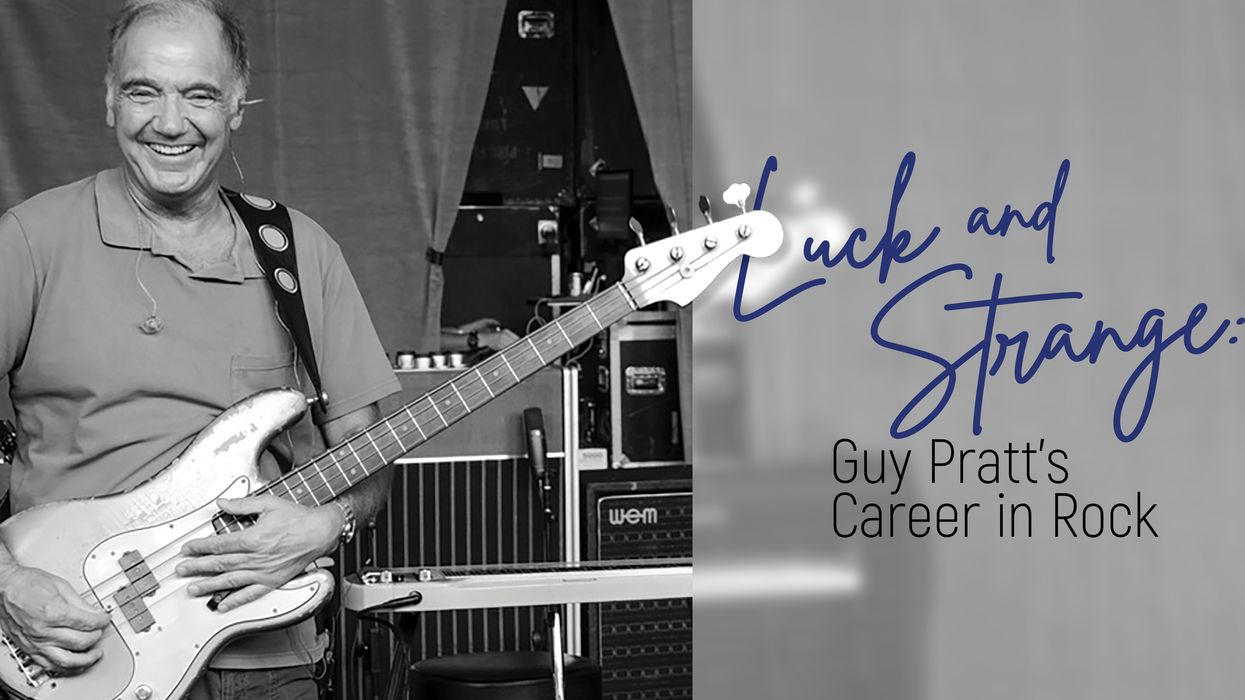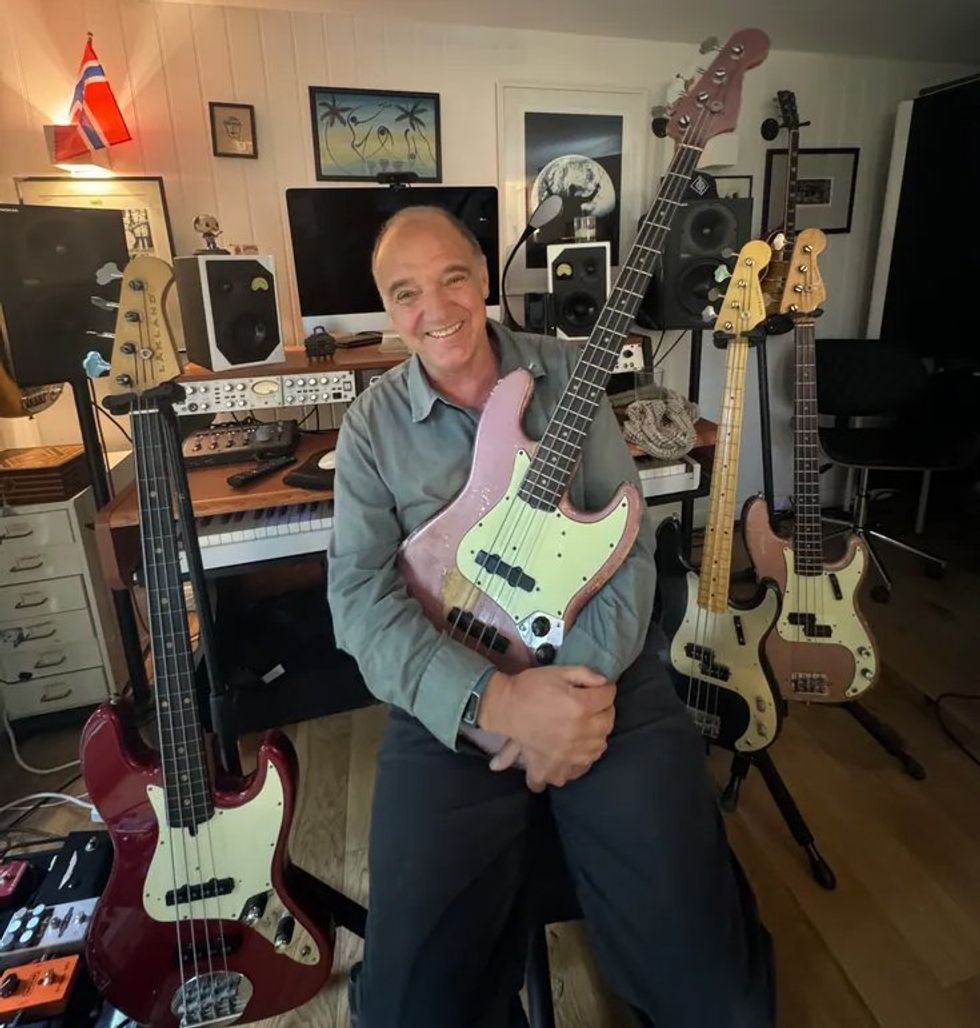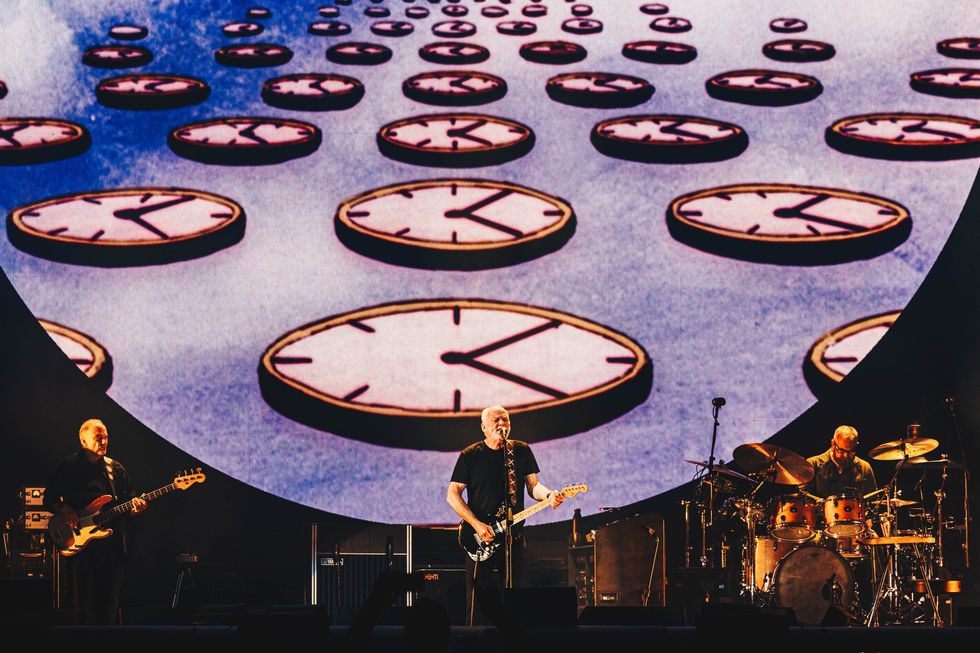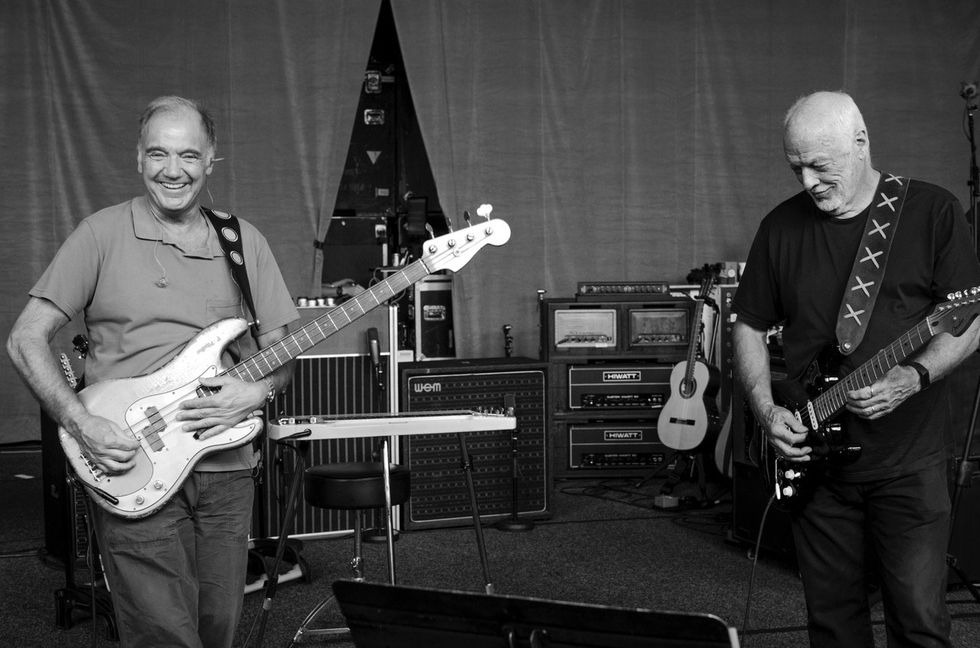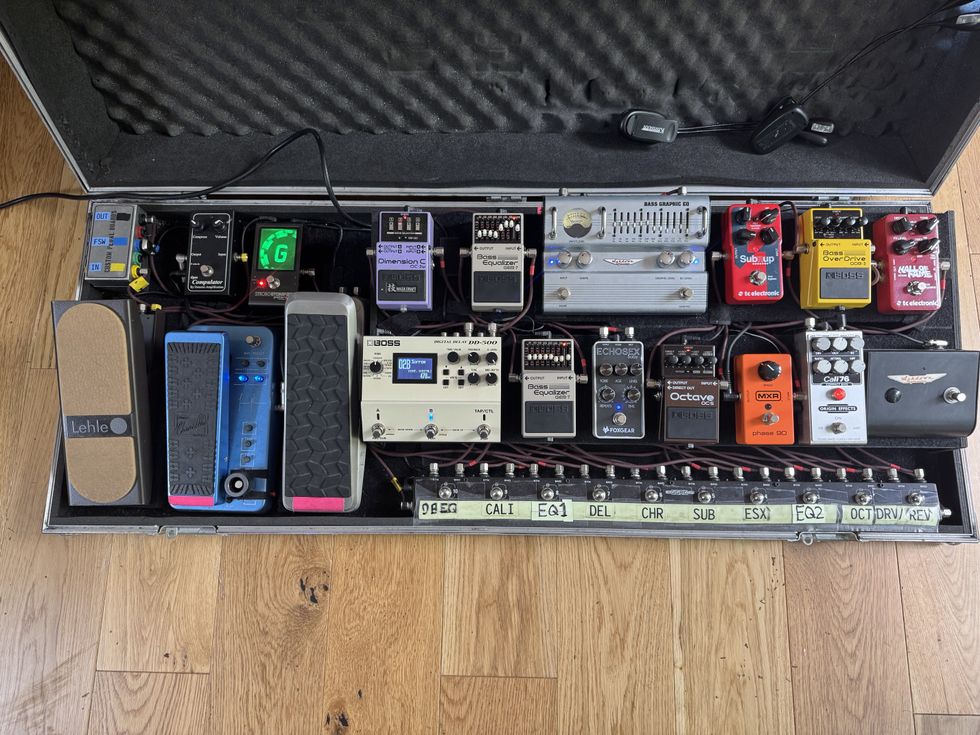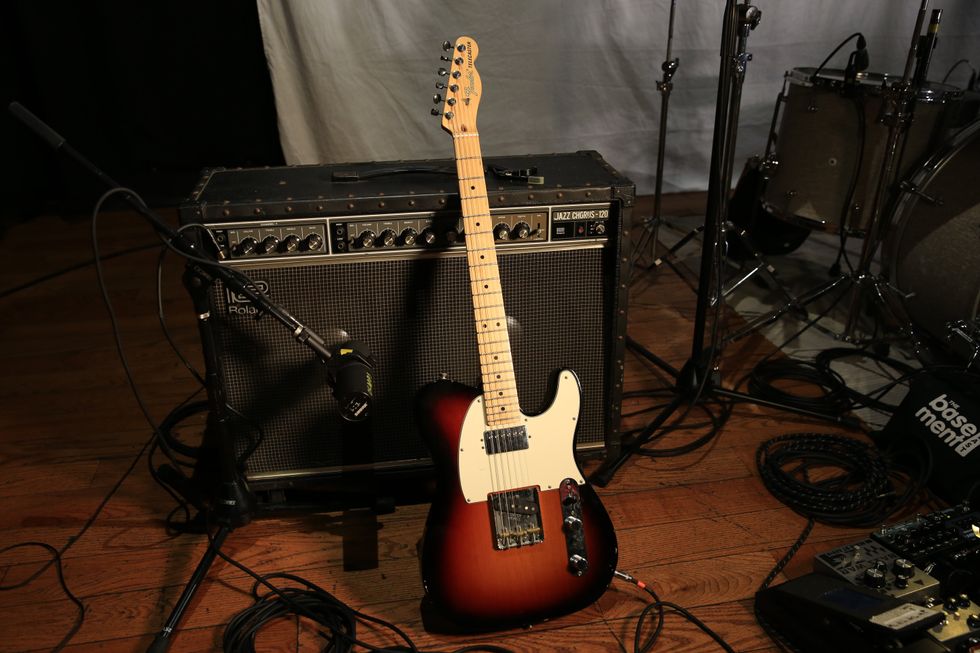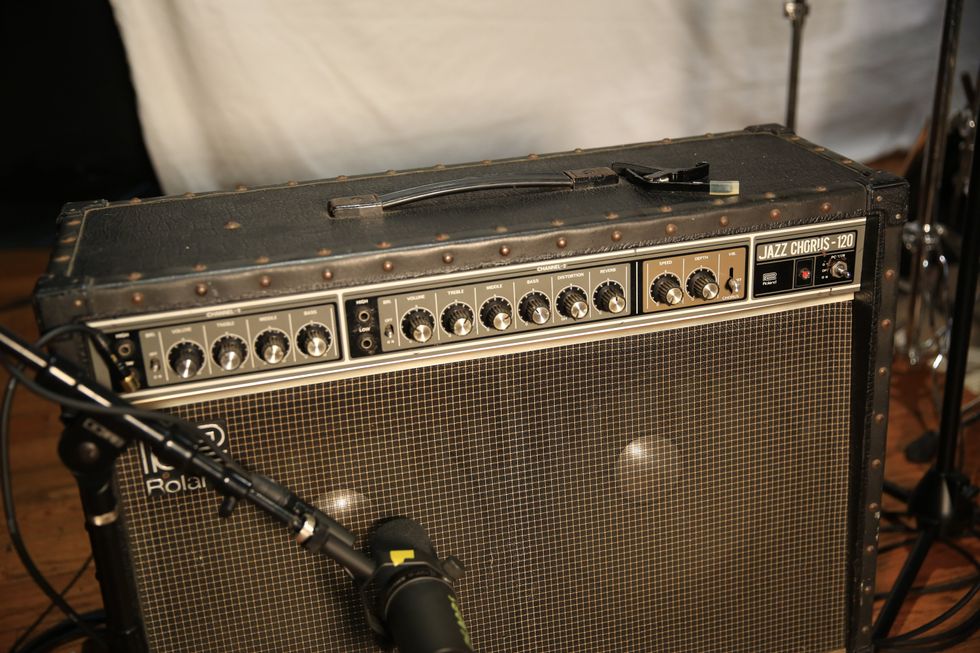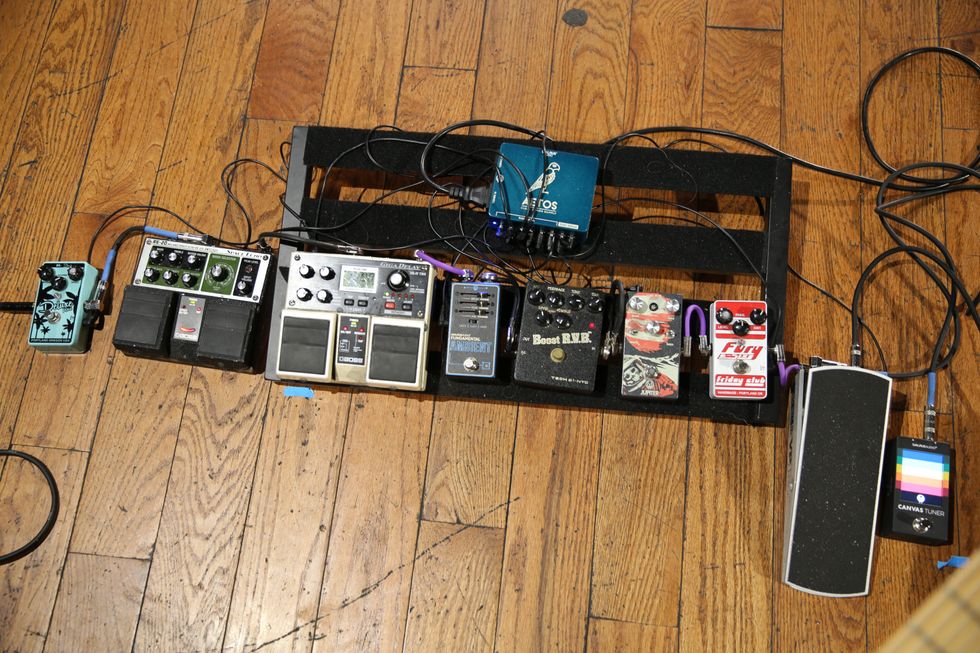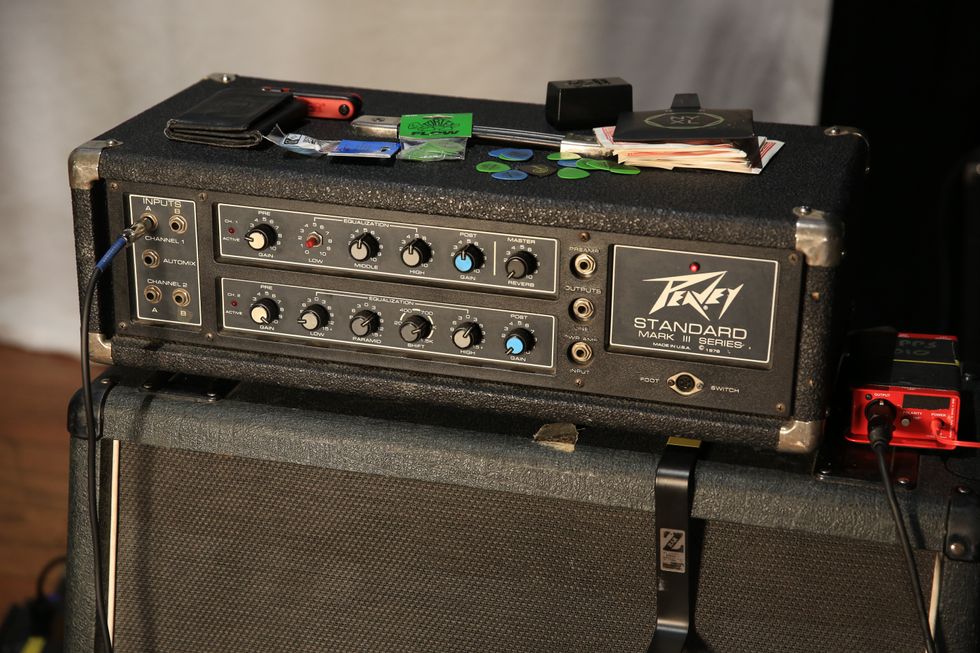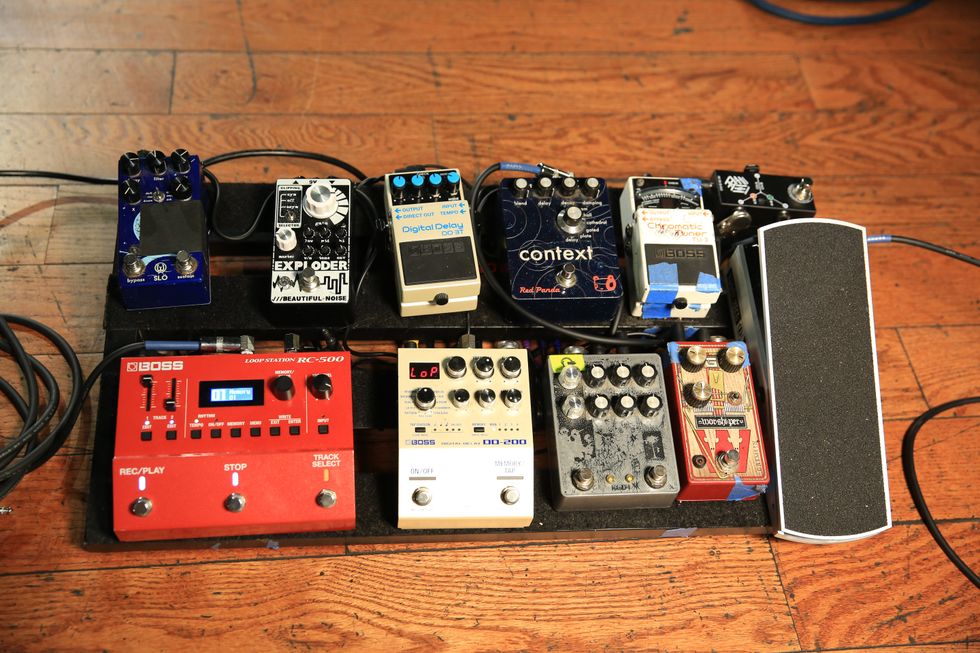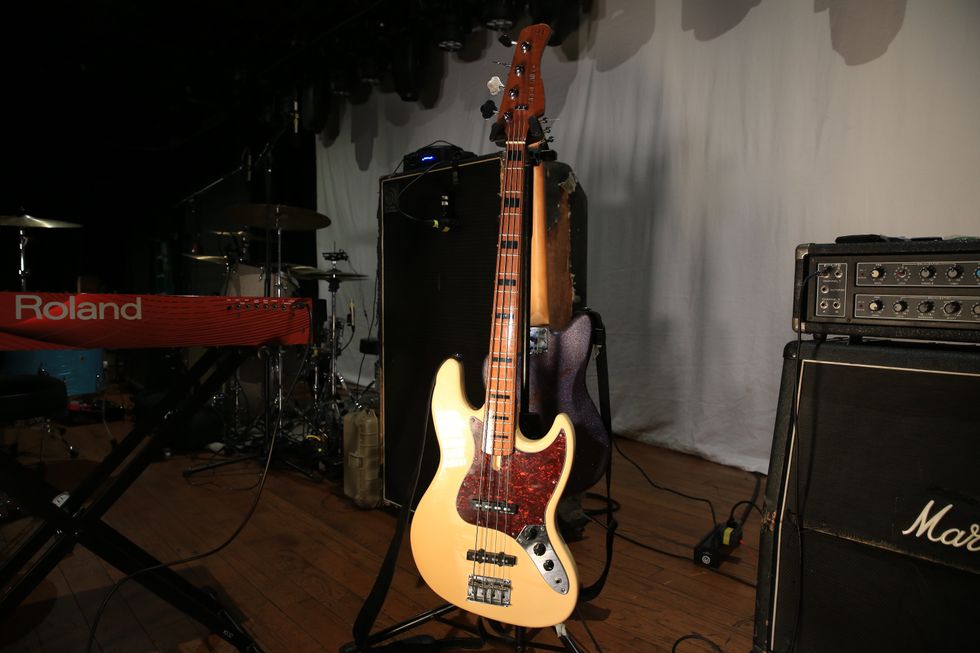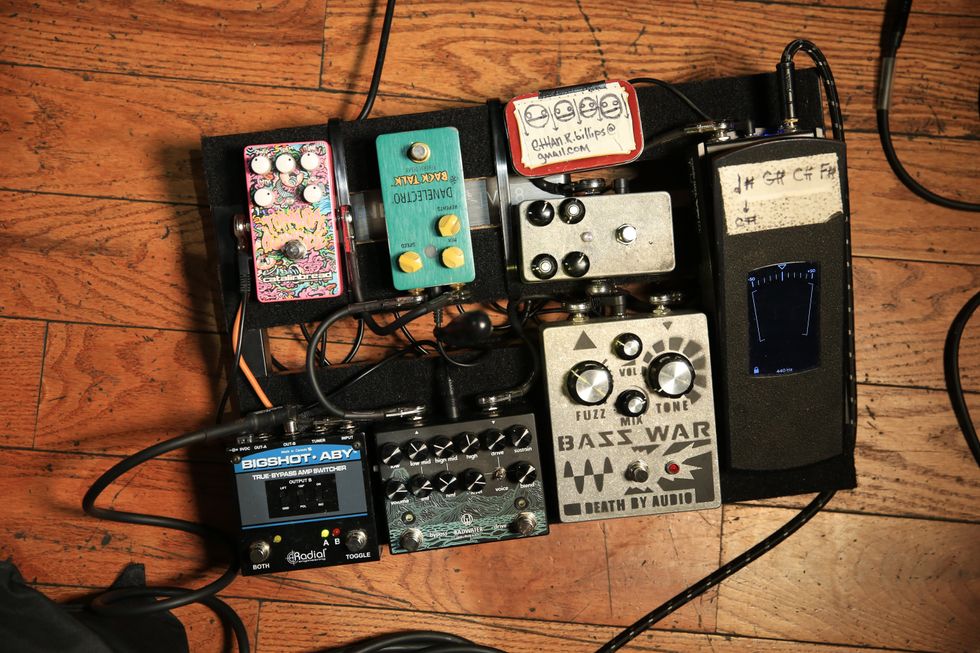| Download Example 1 Flat - tube disengaged, no drive level, all EQ settings at noon. | |
| Download Example 2 Contour EQ - tube engaged, contour at noon, two midrange controls at 2 o'clock | |
| Download Example 3 Tube/drive - tube engaged and drive at 11 o'clock, all EQ settings at noon. | |
| Download Example 4 Flat - tube disengaged, no drive level, all EQ settings at noon | |
| Download Example 4 Contour/EQ - tube engaged, contour at noon and two midrange controls at 2 o'clock | |
| Clips 1-3 recorded with G&L L-2500 5-string bass with Black Diamond roundwounds using the neck pickup in active mode. Clips 4-5 recorded with '74 Fender Jazz with Fender flatwound strings slightly favoring the neck pickup. All clips were recorded with a Shure BG 3.1 mic placed about 6" in front of one speaker, into a Blue Icicle and then into GarageBand on a MacBook. | |
| Watch Video Review: Click for full-size video | |
A Two-Finger Carry
Enter Carvin’s new flyweight bass amp, the BX500, a 500-watt, Class D amp with a switching power supply, all rolled into a package that weighs less than six pounds. When you first pick up this amp, you might think it’s empty inside. The BX500 is a little wider and deeper than most of the ultra light amps out there these days—a trade-off for all the features that Carvin had to pack into its 3”x9”x14” metal box. There’s no handle on the box, so I’d have to say it’s a two-finger carry. There is a rackmount panel available, too, but a rack case would weigh more than the whole amp!
Changing Tonal Colors
The BX500 is a tone chameleon—chock full of options for altering its basic sound, making tones available that are quite different from its native sound with everything set flat. For tone shaping possibilities, the BX500 starts with the usual Bass and Treble knobs, offering 12dB of cut and boost on each. If that doesn’t do the job, you can get a quick tone fix with two bands of semi-parametric EQ offering broadly adjustable frequency centers.
Going one step farther, the BX500 offers a 9-band graphic EQ that’s switchable by either a front-panel toggle or by a footswitch plugged into the back panel. This can be a handy feature for soloing, for EQ’ing two different basses, or for changing up your sound for different musical styles. But there’s still one more EQ option: a Contour knob that scoops out your mids (around 350 to 500Hz) for slapping, or just a warmer tone. The specs show up to -15dB of mid cut, but I thought it was a subtle-sounding control, at least up to the halfway point when the real scooping begins.

Beyond tone, two more options let you make changes to the character of your sound. Somehow, with all that’s going on, Carvin was able to fit in a 12AX7 tube, which is switchable in/out on the back panel. I tried this feature with a few different basses and thought it was very subtle, more a difference in the feel of the attack, along with a bit more fullness on the bottom end. Because it’s all-or-nothing, you’re not able to get a tube grind kind of sound from it.
Which brings us to the second character bender: a Drive knob. Once again, don’t go to this knob for distortion, but for changes in both gain and harmonic content. Although this has a variable level control, you will probably notice the change of gain more than the change of the actual sound. I thought that between a quarter and halfway up, the Drive knob added some grit, growl and attack. To use it, though, the master volume must be lowered to compensate.
The Master Volume control does a lot in its first quarter turn, so that once the drive gets much beyond half, you barely turn on the master before getting plenty loud. If I had my druthers, I would make the master level turn up more gradually, so that it would still be usable when turned halfway up with the Drive knob in use.
Yes, Master
Unlike most amps, the BX500 has a Master, but not an input gain control or an input clip light. Instead, there is an active/passive toggle switch that pads down the input a little bit. The manual doesn’t have the spec for this, but this switch doesn’t produce a big change in volume and seems to accommodate active or passive basses in either position without changing the instrument’s tone.
Some might criticize the DI on the BX500, since it is pre-EQ only (most amps offer a choice of pre or post). I think it’s fine the way it is, especially with a front-panel level control. In most venues, the sound tech wants you to plug into an external DI box, sending just your instrument to the board, and generally prefers a pre-EQ send, since there’s a full-spectrum signal to work with.
Clean power is important, since nearly all contemporary bass amps use a solid-state power amp that gets ugly when distorted. If you want to add distortion to your sound, you do it via an effects pedal. The power output of a bass amp depends on the speaker load it sees. In general, a cab rated at 8-ohm impedance draws less power out of an amp than a 4-ohm cab. For the BX500, that means you’ll get 300 watts from an 8-ohm cab, the full 500 watts at 4 ohms (either one 4-ohm or two 8-ohm cabs). If you’re a slapper or play with a heavy attack, you’ll appreciate the one-knob compressor that lets you get the most out of the amp without distortion. I found the compressor to be reasonably smooth and effective. With just one knob, it’s easy to adjust on the fly.
Very few amps are rated for operation below 4 ohms, because they tend to overheat—a 2-ohm load is very demanding on an amp. Carvin found a way around this, with a switch that lowers the voltage sent to the amp so that you can run the amp at 2 ohms safely. Set up this way, the top power rating is still 500 watts, but if you happen to own a couple of 4-ohm cabs, you really can use them both together. I have never seen another company adopt this innovative solution.
A Four-Ten Cab To Go
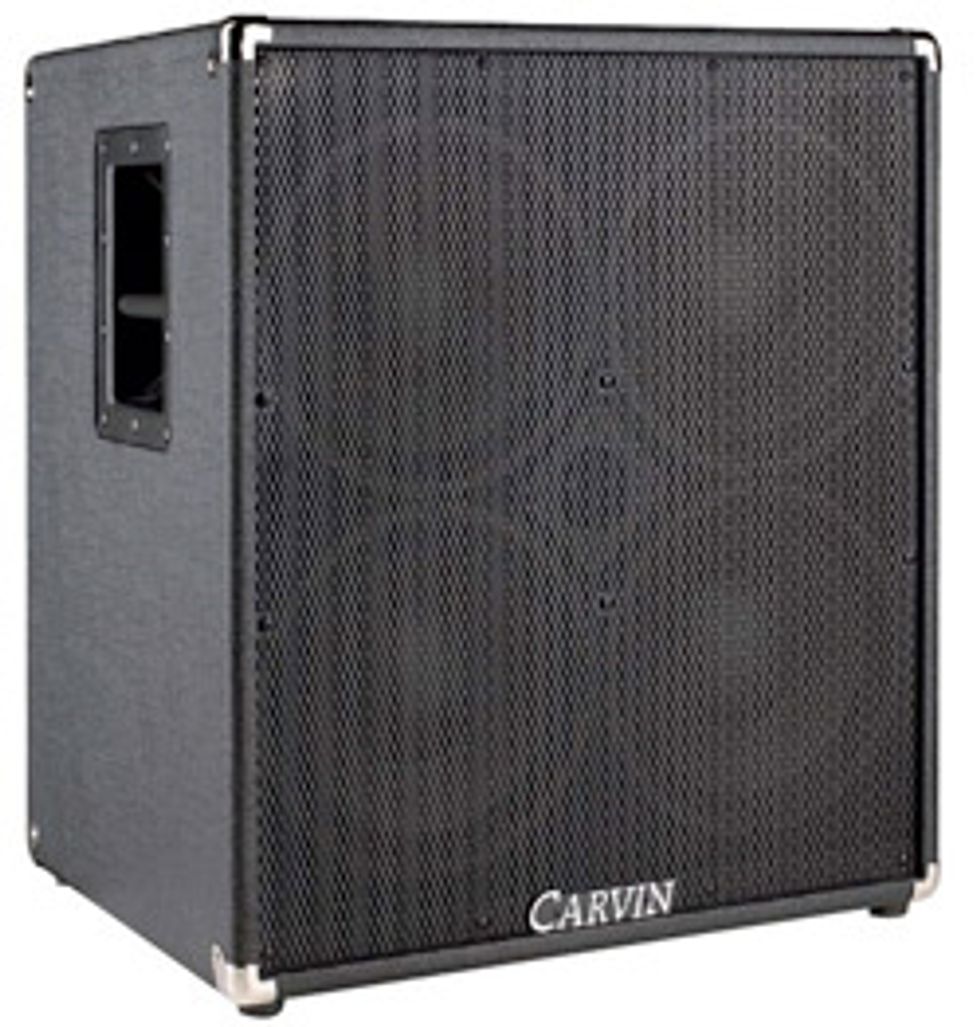 The review amp came with Carvin’s BR410N cab, which uses Neodymium speakers and is rated at 4 ohms and capable of 1000 watts of power handling (an 8-ohm cab is also available). Happily, the construction is all birch plywood rather than the super-heavy, less durable MDF or particleboard. There are front-to-back braces made of the same material inside for better stiffness. Carvin chose a relatively unusual sealed cab design, which produces a smoother sound spectrum, usually at the sacrifice of some low end and efficiency. (Carvin rates the cab’s efficiency at 106dB at 1 watt, but I’ve yet to find a cab rated that high and would just say that it’s “reasonably efficient.”)
The review amp came with Carvin’s BR410N cab, which uses Neodymium speakers and is rated at 4 ohms and capable of 1000 watts of power handling (an 8-ohm cab is also available). Happily, the construction is all birch plywood rather than the super-heavy, less durable MDF or particleboard. There are front-to-back braces made of the same material inside for better stiffness. Carvin chose a relatively unusual sealed cab design, which produces a smoother sound spectrum, usually at the sacrifice of some low end and efficiency. (Carvin rates the cab’s efficiency at 106dB at 1 watt, but I’ve yet to find a cab rated that high and would just say that it’s “reasonably efficient.”)The front grille of this cab is made of sturdy perforated steel, and the cab is covered with a tough, vinyl material that comes in various colors. Unlike most cabs, Carvin chose old-school metal corners. More common are plastic corners that lock for stacking cabs. The metal corners don’t lock, but can take a lot of punishment without cracking. There is a beefy metal carrying handle on each side that will no doubt hold up through years of hauling, although the carrying position felt a little awkward. Caster sockets are already installed at the factory, so if you prefer to roll your cab, just add a set to your order. At a spec’d 65 pounds, this cab is relatively easy to manage either way. Many conventional 4x10 cabs weigh in at 90-plus pounds.
The back panel has plenty of places to plug in, with two 1/4” jacks and two Speakons. In addition, the panel includes a six-position Attenuator switch (5 levels plus off) for the titanium horn tweeter.
Dialing In For Live Action
What does this rig sound like? Set flat, without the tube or drive, the amp sounds clear, but not particularly deep, and not adding anything distinctive to the sound coming out of the basses I tried it with. To give it a close listen, I first plugged in a set of studio headphones (no speakers) and worked with the EQ sections. The headphone jack doubles as a tuner out and as such, a few parts of the amp are out of the circuit, including the master volume, graphic EQ, effects loop and the mute switch.
In this mode, headphone volume is controlled by the active/passive switch and the Drive knob. My test basses, a G&L 5-string and a Jazz-style fretless, each sounded good through my cans, with high clarity and minimal hiss. The Drive knob did little to change the character of the sound, but the range of the Contour knob between noon and 3 o’clock was helpful for dipping the bright or honky mids. Beyond 3 o’clock, the sound was seriously scooped. Bumping the lower midrange knob, centered at 200Hz, added a good thump to the sound, while increasing the high-mid knob, with a useful 900Hz upper midrange, could easily add some needed bite in muddy rooms. In all, the headphone output will make for a pleasant silent practice rig, but because the effects loop is out of the equation, you won’t be able to play along with music this way. I was a little disappointed at this, since even basic practice amps allow music to be inserted from your iPod.
Switching to the BR410 cab produced much of what I’d heard through the phones. The amp delivered good punch and mids, but lacked the depth I’d hoped for. In a studio jam session with two guitars in medium-sized combo amps plus a drum set, the rig easily held its own, creeping the Volume knob only to about 9 o’clock before I had all the sound I’d ever need (of course, the G&L has probably the hottest signal output around). Bumping up the low-mid EQ knob quickly added the kick I wanted. With my Jazz-style bass sporting active EMG pickups, I was able to get a wider range of volume settings because of its more normal output level.
The cab sounded tight and well-defined throughout its range, never showing a hint of weakness, even as I crept the master up toward noon (at which point, the others were pushing their fingers into their ears). Turning the Drive up to about noon added some aggressiveness to the attack. Because the parametric midrange controls did their jobs so well, I never got into the graphic EQ at that session. For most situations, I would use it mainly for creating a second bass sound, or for adapting the amp’s basic setting for a gig with two vastly different sounding axes.
The Final Mojo
The combination of the Carvin BX500 and the BR410 proves to be a potent rig for a variety of electric bass gigs, allowing all the volume and tonal flexibility you’d need for unsupported gigs up to medium size, and likely serving all your gigging needs once you’re in the house PA. If you gig or rehearse in a place that provides a house speaker cab, it’d be a dream to roll up with your bass in a gig bag and the BX500 stashed in a heavy-duty, padded nylon carrying case like the one Carvin offers. As a player, my main wish for this rig would be to have a Master Volume with a wider range of usability, say between 9 o’clock and 1 o’clock. A player facing a variety of gig sizes might want to pick up something like Carvin’s BR210N and BR115N cabs to gain greater flexibility in rig sizes. But if you need a one-size-fits-most rig, the BR410N is an effective solution at under $1K.
Buy if...
you're looking for a relatively light, loud rig with good clarity and flexibility.
Skip if...
you like an amp that can add grit to is sound, or if its headphone practicing options don't meet your needs.
Rating...
Street BX500 $419; BR410N $529 - Carvin Guitars - carvinguitars.com |



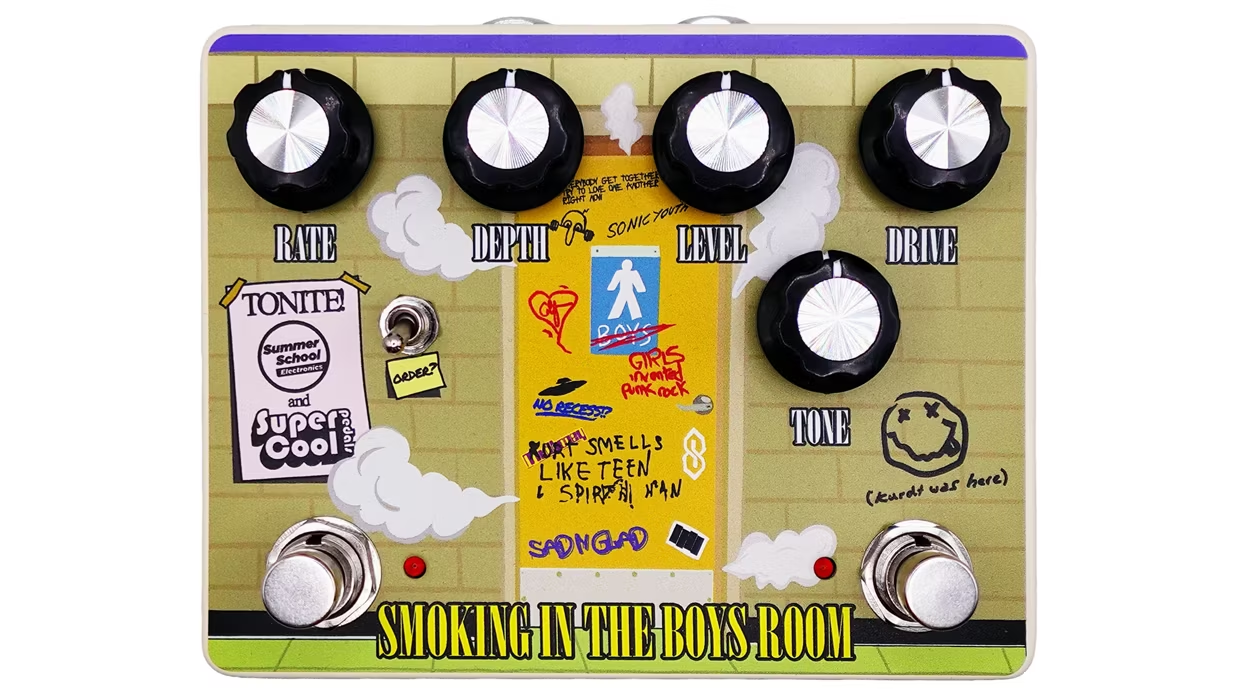

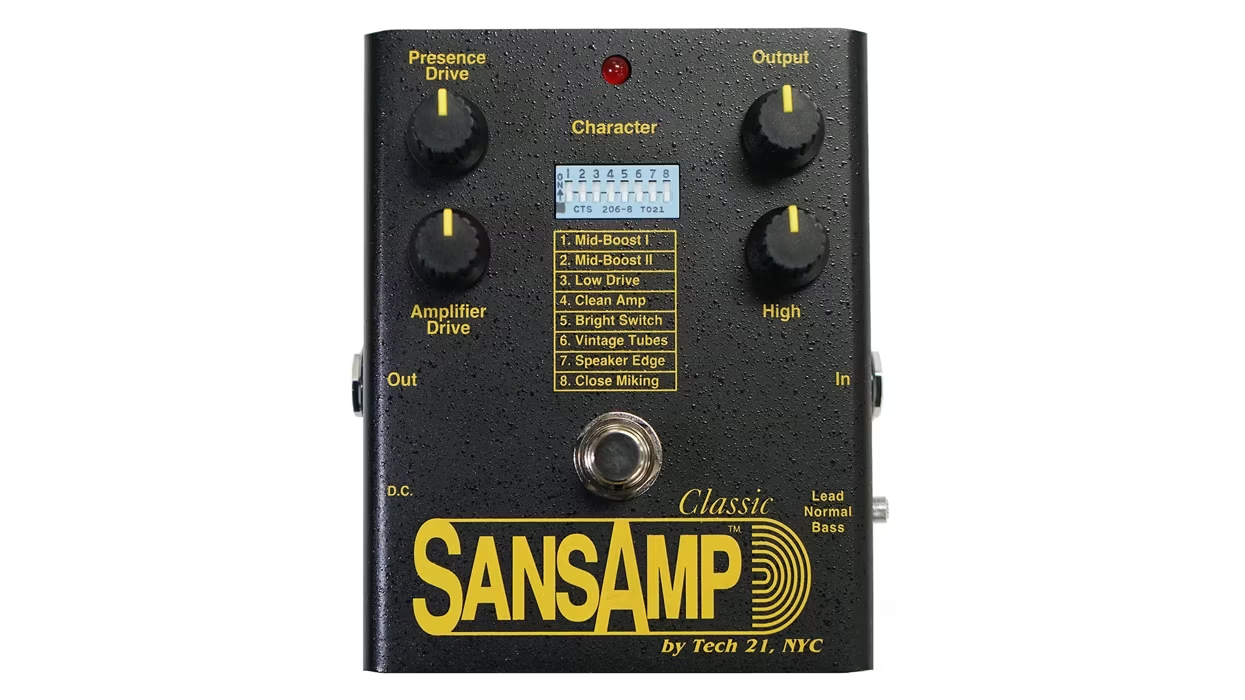
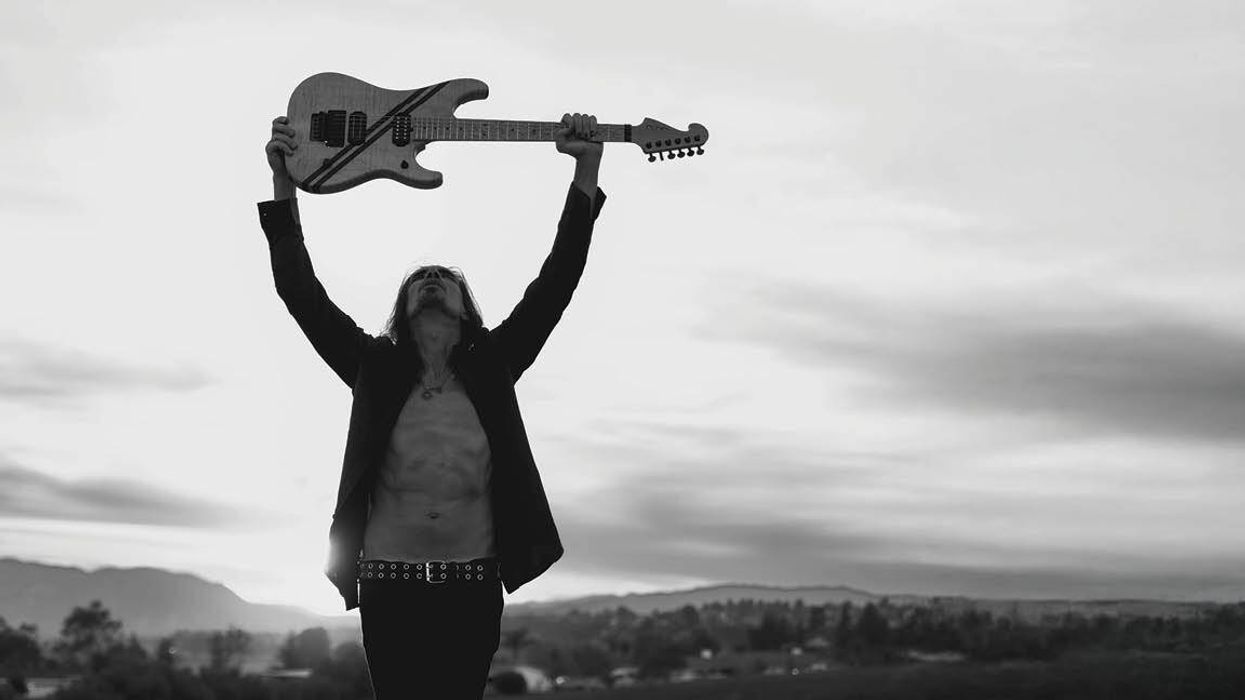
![Rig Rundown: AFI [2025]](https://www.premierguitar.com/media-library/youtube.jpg?id=62064741&width=1245&height=700&quality=70&coordinates=0%2C0%2C0%2C0)












 Shop Scott's Rig
Shop Scott's Rig![Rig Rundown: Russian Circles’ Mike Sullivan [2025]](https://www.premierguitar.com/media-library/youtube.jpg?id=62303631&width=1245&height=700&quality=70&coordinates=0%2C0%2C0%2C0)


